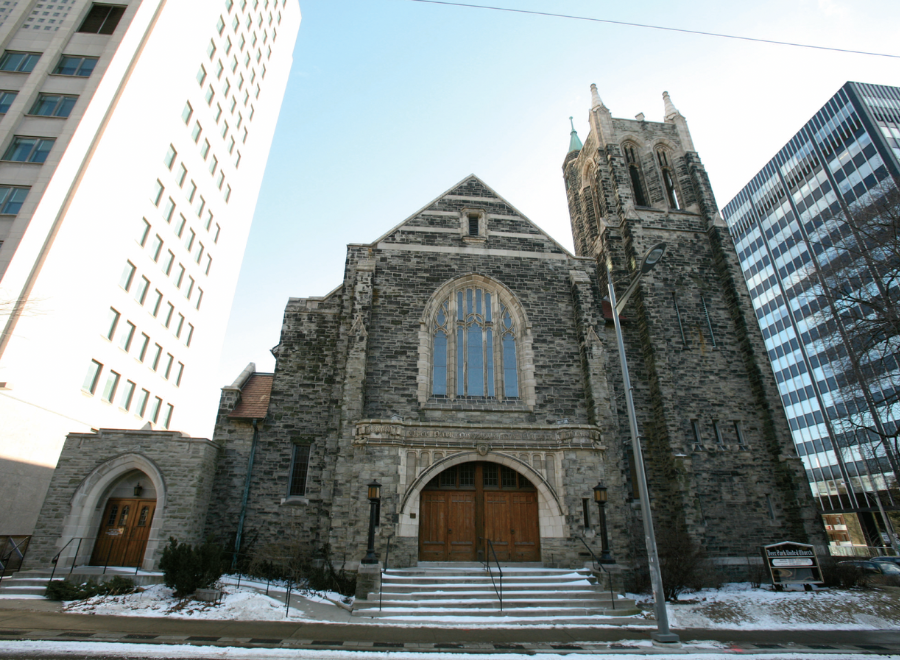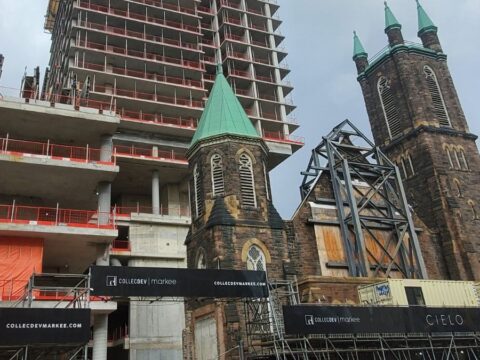With its soaring 19th-century Gothic Revival design and historical stained glass windows, Fort Massey United is one of Halifax’s architectural landmarks. The church’s municipal and provincial designations as a heritage site ensure that it’s well cared for.
Across town, the congregation at St. John’s United has moved out of its 90-year-old building and hopes to redevelop the half-acre site to include seniors’ housing and a new sanctuary. The old church has crumbling bricks, mould, asbestos and dubious heritage value, but some non-churchgoing neighbours are already questioning its replacement. “There’s a whole value placed on aging buildings,” says Rev. Linda Yates. “It’s just a knee-jerk reaction.”
You may unsubscribe from any of our newsletters at any time.
At a time when United Church congregations are increasingly considering amalgamations, redevelopment projects or outright sale of their properties, many are running into road-blocks over the buildings’ historical value. Urban congregations with valuable property that could allow them to redevelop are often forced to work around redundant buildings instead of building anew. Rural congregations, faced with decreasing membership and deteriorating buildings, are often forced to abandon or demolish them despite their historical significance.
Being designated as a heritage building carries a certain honour. But it can also carry a cost, hobbling efforts to mov ahead in mission. As Rev. Trent Cleveland-Thompson of Fort Massey United puts it, “You can go overboard. Our churches are not museums. And when the museum takes over the church function, it’s not healthy.”
Heritage designation or the preliminary action of listing the property can come from municipal, provincial or federal governments or their agencies. Each carries different implications in different provinces. Designation or listing by municipalities usually carries little weight beyond the community, bu ta provincial heritage designation (sometimes carried out by municipalities) usually makes a building difficult to alter and impossible to demolish without a legal battle. Churches designated by the federal Historic Sites and Monuments Board as places of “National Historic Importance” can’t be altered without government permission. There is no clear count of United churches with provincial or municipal heritage status, but they likely number in the several hundreds.
National designation at least brings the possibility of federal restoration funding. In Quebec, provincial designation can also be helpful. The government-funded Religious Heritage Council has handed out close to $200 million in the last 15 years to restore and maintain heritage church buildings, including $3.8 million as part of a 2006 restoration at St. James United in Montreal. In the rest of Canada, though, provincial and municipal heritage restoration budgets are small and funding is hard to access.
The federal definition of heritage value as “aesthetic, historic, scientific, cultural, social or spiritual importance for past, present or future generations” is fairly clear. But provincial criteria can be more problematic. In Ontario, faith groups have banded together to challenge new regulations adopted about five years ago. The new rules widen the concept of heritage to include “direct associations” with an “organization or institution that is significant to a community” or buildings that are simply landmarks.
United Church General Council staff person Erik Mathiesen has joined with other faith groups in appeals that have reached as far as the premier’s office. Though political progress has been slow, Mathiesen’s advice is simple: always avoid heritage designation.“Once a property is designated under the current legislation,” he says, “the church has basically ceded all control over the property.”
Deer Park United in downtown Toronto earned that lesson first-hand when the city gave its 1913 building a heritage designation about two years ago, shortly after the congregation decided to move and sell. Discussions with a developer who wanted to purchase the property and demolish the building fizzled. The congregation was left to maintain an unheated vacant building and find a buyer willing to work with the existing structure.
A pending sale was in place by early this year. But Fred Graham, chair of the Deer Park Board, says the designation cost the congregation at least $1 million and countless volunteer hours. Deer Park is now sharing space in a neighbouring Presbyterian church and considering a longer-term shared ministry arrangement. “We did the best we could,” says Graham, calling the heritage listing “a serious challenge to church life.”
Uptown, Asbury and West United has been trying for about five years to build a new church and affordable housing on its 1.75-acre site. Tearing down its 1950s-era, poorly insulated, asbestos-contaminated church makes the most sense. Even without a designation in place, though, the city’s Heritage Preservation Services department has pressured the congregation to work with the existing building, adding at least $1 million in extra costs to the proposed project.
“Churches are being coerced and told that they must keep these old buildings,” says Pauline McKenzie, chair of Asbury and West United’s architecture sub-committee. “It’s a form of expropriation without compensation…It really infringes on the rights of denominations to decide how best to serve their communities.”
Heritage listing isn’t always a problem but it often means the non-church community must adopt a sense of local responsibility. In Oshawa, Ont., hard hit by the economic downturn, Simcoe Street United has become a “beacon for those in need,” says Rev. David Moore, offering community meals, a food pantry, winter coat distribution and advocacy service. The church is also the city’s first designated heritage property. “This is not just our building, it’s Oshawa’s building,” says Moore. He hopes that support will translate into financial help when the congregation starts fundraising for about $500,000 in needed repairs to its spire.
Natalie Bull, executive director of the non-governmental Heritage Canada Foundation, says a church’s property-tax exemptions represent “an investment in that building by the broader community. The responsibility is not necessarily to hold onto a building when it is completely outside your financial resources, but there is a responsibility to work with the community.”
The Heart’s Content (Nfld.) pastoral charge was finalizing an agreement early this year to do just that, saving a church that made a short-list of endangered heritage places last year. Instead of being demolished, Heyfield United will be maintained by a local heritage society that is successfully developing the town as a tourist destination. “It’s great to be able to keep our heritage intact,” says Ray Case, lay minister for the pastoral charge, “but I have some reservations about keeping up all these churches as shrines.”
Many churches in rural Nova Scotia are likely to be demolished, says Jim St. Clair, an active United Church layperson and heritage building expert in Cape Breton. Inverness-Guysborough Presbytery, he says, has 39 buildings in nine pastoral charges “and almost all of them are historical. As an architectural historian, I am loathe to say tear any of them down. But this probably isn’t good stewardship.”
Cataloguing churches with heritage value would be a good idea, says Trent Cleveland-Thompson, because “we have too many, and we should decide which ones we should save.”
As heritage supporter Natalie Bull points out, it’s “a challenge that faith groups and local communities and governments are going to have to tackle together.”
At one level, Linda Yates of Halifax agrees. But like many church leaders and congregations, she also sees a gap in understanding that may be hard to close. “We see the church not as a building but as a community and what that community can do with the spirit of God,” she says. “But the outside community sees us as a building.”
***
This story first appeared in The United Church Observer’s April 2010 issue with the title “History lesson.”














